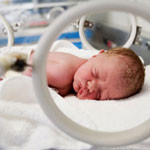Oklahoma Mother Raising Erb’s Palsy Awareness
 An Owasso, Oklahoma mother is working to raise awareness of Erb’s palsy, after her daughter received a brachial plexus injury at birth. The mother, Amber Lucas, had never even heard of the condition until the difficult delivery she experienced when giving birth to her daughter, Olivia.
An Owasso, Oklahoma mother is working to raise awareness of Erb’s palsy, after her daughter received a brachial plexus injury at birth. The mother, Amber Lucas, had never even heard of the condition until the difficult delivery she experienced when giving birth to her daughter, Olivia.
During the delivery, Olivia’s head became stuck under her mother’s pelvic bone. The umbilical cord wrapped around the infant’s arm and head, trapping her. In a quick effort to save Olivia, the doctor pulled her left arm, which caused a brachial plexus injury, resulting in Erb’s palsy. The nerves controlling the infant’s left hand, arm, and shoulder were torn. Lucas credits the quick thinking of the doctor for saving her daughter’s life.
After receiving diagnosis of her brachial plexus injury at six weeks, Olivia began weekly physical therapy sessions. When she was eight months old, she underwent at three-hour nerve graft surgery at St. Louis Children’s Hospital.
Infant continues to progress
Olivia is now 14 months old and she’s still experiencing limitations, such as not having the ability to reach in her back pocket or turn her palm to the sky. However, her family is positive about the things she can do, such as pulling things down, trying to climb, and lifting objects heavy for a toddler.
For the past two weeks she has been wearing a new brace to help straighten her arm and is continuing with her weekly physical therapy sessions.
While Olivia may require additional surgeries in the future, doctors are currently very pleased with her progress.
About Erb’s palsy
Erb’s palsy occurs when an infant experiences a loss of movement or weakness of the arm when the collection of nerves around the shoulder is damaged during birth. Approximately 0.3 to 2 infants are impacted per 1,000 births. The nerves of the brachial plexus can be injured during a difficult delivery, if the baby is larger than average, or if shoulder dystocia occurs.
There are a number of different forms of brachial plexus, categorized by the amount of arm paralysis experienced by the infant. Brachial plexus injuries typically only affect the upper arm, while Erb’s palsy impacts the upper and lower arm. Klumpke paralysis is another form, affecting the hand of a newborn, which may also include an eyelid droop on the opposite side of the body.
Symptoms can be seen at birth or soon after.
Common signs of Erb’s palsy include:
- The infant not moving the upper arm, lower arm, or hand
- Absent Moro reflex on the impacted side
- Arm bent and pressed against the side of the body
- Weaker grip on the impacted side
Results of brachial plexus treatments have been promising. Patients treated at the Center for Brachial Plexus and Peripheral Nerve Injuries at Children’s Hospital and other hospitals performing surgeries to repair the condition show that 40 to 80 percent of patients see improvement of one grade in at least two of three major muscle groups after the primary surgery neurolysis with or without grafting. One grade improvement means the return of major functioning in the extremity.
Advances in technology have made brachial plexus injury much less common, as cesarean delivery is now used when doctors have concerns about a difficult delivery.


